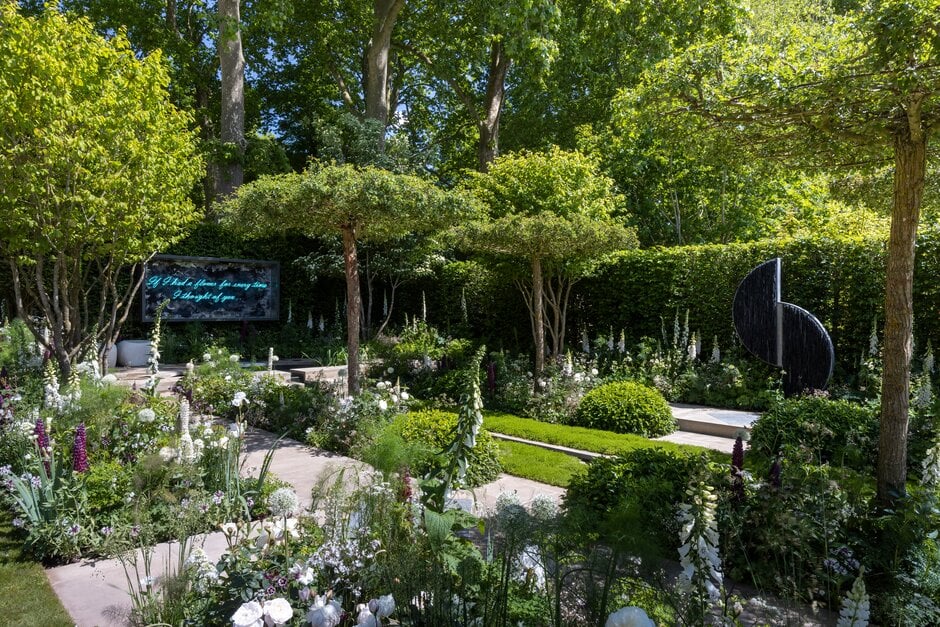Top tips to create a forest bathing garden
Turn your garden into a mindful sanctuary with ideas to steal from the RHS Forest Bathing Garden
What exactly is forest bathing? Simply put, it means spending time outdoors in a mindful way and engaging your senses to notice the sights, sounds and smells of the forest – from the different colours, textures and patterns of plants around you, to the joyful sound of birdsong or wind rustling through the trees.
But you don’t have to be in a forest to experience the wellbeing benefits of observing nature. The RHS Forest Bathing Garden, created by award-winning garden designer Dave Green, shows how you can create a green space for mindfulness in a much smaller setting.
A stand-out feature of the 2022 RHS Hampton Court Garden Festival, this woodland-style garden is packed full of take-home planting ideas to help engage the senses and relax the mind, no matter how big or small your garden space.
1. Go for green
To maximise the impact, mimic the planting layers of the woodland, incorporating trees to give a shady green canopy, shrubs to provide a hit of green at eye level, and lush plants at ground level to light up beds, borders and shady corners.
2. Visual variety
Ferns are a favourite woodland plant and many have intricately shaped leaves and wonderful jagged edges to captivate the eye. Blechnum spicant (hard fern) has bright green lance-shaped fronds with smooth leaflets, while Dryopteris wallichiana (alpine woodland fern) has finely dissected, lace-like fronds on blackish-brown scaly stems.
Dot around plants with different foliage colours to draw your eye through the planting. Deciduous shrub Sambucus nigra Black Lace (‘Eva’) demands your attention with its dramatic almost black foliage and soft, feathery leaf shapes.
3. Textural treats
Positioning grasses next to paths or seating areas offers the chance to stroke their tactile foliage and enjoy the soothing rustling sounds they make as you brush past. The grass Deschampsia cespitosa ‘Bronzeschleier’ has touchable thread-like leaves and frothy golden flowerheads. For damper areas in the garden, use grass-like sedges, such as Carex testacea ‘Prairie Fire’, for textural effect.
4. Scented gems
For a more powerful hit of fragrance, add plants with scented flowers to your garden space. Viburnum × bodnantense ‘Charles Lamont’ is adorned with clusters of pink perfumed blooms on bare stems from autumn to early spring. Not only does Sarcococca confusa (sweet box) have lustrous deep green leaves all year, in winter its small but strongly fragrant, creamy-white flowers scent the air.
5. Seasonal stars
The deciduous shrub Physocarpus opulifolius ‘Diabolo’ is sure to catch your eye in autumn, as its deep purple leaves turn to fiery red. For a shrub with showy flowers and radiant stems, Hydrangea paniculata ‘Wim’s Red’ is a fantastic choice. Held on red-tinted stems, its large white blooms mature to deep red in autumn before taking on a delicate skeletal quality in the winter months.
For flower colour to brighten winter days, the nodding flowers of Helleborus × hybridus Harvington pink speckled can last for months and provide important nectar for early pollinators on the wing.
6. Admire the view
Even if you don’t have a garden, you can still experience the feel-good power of plants. Choose a range of houseplants with interesting leaf shapes, colours and markings, and group them together in a quiet corner of your home, to create a leafy green sanctuary to practise mindfulness.


